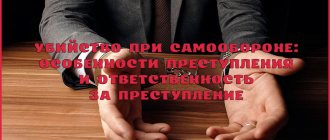Criminal legal characteristics
- This crime should not be confused with infanticide, as this concept is broader. In this case, the objects of the crime, subjects, age characteristics and the subjective side may differ. The crime has recently been classified as a privileged act.
- The legislator recognizes a newborn as a child under four weeks of age. This is the first condition of the crime, which relates to the personality of the murdered person. If an attack was committed on a stillborn child, then the act is assessed as an attempt on a worthless object, according to neonatology.
- The second condition regarding the signs of the objective side is the timing implied in the phrase “immediately after childbirth.” Obviously, we are not talking about days or even hours. The article describes two time categories - immediately and later.
The killing of a newborn by a mother later in time is expressed as one hour after birth until the newborn is four weeks old, anything less than this time is an immediate homicide.A mother who killed a child more than a month after the end is classified under Article 105 - murder.
- The third condition determines the personality of the mother. The subject of this article is a woman-mother who has reached 16 years of age. The legislator pays special attention to the mental state of the mother, using the phrase “psychotraumatic situation”, “mental disorder” in the article.
It is assumed that during and immediately after childbirth, a woman is in a state of severe mental overload, which reduces her ability to recognize the social danger of her actions and manage them, and this principle forms the basis of the article.This condition is considered similar to limited sanity and also manifests itself in the postpartum period. The condition does not arise at once, but accumulates in the mother against the background of negative emotions against the background of the negative impact of mental stress. Taking into account the traumatic situation is the main condition of this article.
- Earlier we talked about the presumption of severe mental stress during and after childbirth, which the legislator assumes. However, if in a particular case it turns out that the birth went smoothly and did not cause noticeable mental disorders in the mother, but nevertheless the mother, for certain reasons, killed the child before or during childbirth, then the act should be qualified on a general basis, according to Article 105 of the Criminal Code of the Russian Federation Federation is like murder.
- Murder during and immediately after childbirth can be committed only by action (strangulation, hitting the child on the head), and at a later time also by inaction (refusal to feed, leaving the child without help).
- Let's consider the subjective side of killing a newborn. A crime can be committed with direct or indirect intent, either suddenly or with premeditated intent.
- The official commentary states that the emergence of a murder plot before childbirth should be considered by the court and affect the punishment, regardless of the chosen qualification.
- The murder of a newborn child by a mother is a crime of moderate gravity.
Other situations covered by this article
If the murder of a child does not have any mitigating circumstances, the mother will suffer severe punishment.
Immediately after birth
Doctors note that the period “immediately after birth” occurs in the first 2-4 hours, until the placenta is completely released from the woman’s body. If, after this period, no complications are detected in the woman, she can be considered completely healthy. In some cases, this period is considered as 24 hours.
If the crime occurred later than one day after the birth, then it is classified as the murder of a minor.
In conditions of psychotrauma
The murder of a child will be qualified under Art. 106 of the Criminal Code of the Russian Federation in the event that it occurred:
- within one month from the date of birth;
- The woman in labor has a psychological trauma that arose due to her life situation (no money to support the baby, no housing, mother and child were kicked out of the house, the father refused to fulfill his parental obligations).
Psychological traumas that are not related to the condition and circumstances of the life of the woman in labor cannot be taken into account.
Mental disorder with preservation of sanity
The crime will be considered under Art. 106 of the Criminal Code of the Russian Federation if:
- the child was no older than 1 month;
- The mother has been diagnosed with a mental disorder. It does not have to be associated with childbirth and postpartum psychosis. Perhaps the woman in labor had the disease before;
- the mother is in a sane state.
Note!
If the mental disorder has a scale where sanity is excluded (fever, delirium, hallucinations), criminal liability for the crime committed is not assigned.
A murder that occurred, for example, as a result of an exacerbation of postpartum depression, when the child was more than 1 month old, is classified as the murder of a minor. The punishment for this crime is 8 years in prison.
The murder of a newborn child is a serious crime, however, there are many mitigating circumstances. Each such case has its own characteristics, which only an experienced lawyer can understand. To get advice from our specialist, call the number provided or fill out the form on the website.
Extenuating circumstances
The murder of a newborn child by a mother is considered committed under mitigating circumstances if at least one of three criteria is met:
- the crime was committed during or immediately after childbirth;
- the mother is subject to mental trauma;
- The woman in labor is in a state of mental disorder that does not preclude sanity.
For the first condition, the legislator indicates, according to forensic medicine, that the child should be no more than a day old, since it is during this period that the mother is in a serious psychophysical condition and is not able to understand the meaning of her actions and manage them, unless the contrary is proven.
For the other two murders under mitigating circumstances, it is important that a psychotraumatic situation can arise before and after childbirth, as a result of the accumulation of negative emotions that the woman cannot cope with due to a malfunction in the psyche. In this regard, she cannot control and predict her actions, as well as their possible consequences.
Signs and elements of a crime according to Art. 106 of the Criminal Code of the Russian Federation
The legislator names three signs under which a crime can be considered committed under Article 106 of the Criminal Code of the Russian Federation:
- four situations (during childbirth, immediately after childbirth, in a state of mental disorder that does not exclude sanity, in a psychotraumatic situation);
- special subject - mother;
- the victim is a newborn.
We are talking about three independent elements of crime, identified for different reasons.
Thus, let's look at the elements of the crime:
- The subject is the mother of a newborn child who has reached the age of 16, who is also the performer.
- The object is the life of a newborn child.
- The objective side is a conscious action or inaction aimed at taking the life of an infant. There are active and passive infanticide; the first type is more common. Let's give an example: hitting a baby on the head immediately after birth with the intent to kill is an active action, and purposefully depriving a child of food is passive inaction.
It is important to determine the time period of the crime, since the process of childbirth does not coincide with the process of giving birth to a child.We will assume that after the separation of the fetus from the body of the child's mother, through childbirth with a gestation period of at least 22 weeks, and weighing at least 500 grams or less than 500 grams in case of multiple pregnancy, a new subject appears. Important signs of a live birth of a child are breathing, pulse, pulsation of the umbilical cord.
Prerequisites for a woman’s psychophysical overload can arise even before childbirth - her husband’s betrayal, difficult financial situation, psychosis, stress at work, scandals in the family, and so on. The situation must have a decisive influence on the motive to kill the newborn.
- Subjective side. Guilt can be with direct or indirect intent, both with sudden and premeditated intent.
For example, a husband threatened his pregnant wife to leave the family if a girl was born. To keep her husband, the woman went to give birth to a friend in another city at home in order to hide the fact of childbirth. After the child's umbilical cord was cut off, the mother strangled the girl. Thus, this crime was committed with direct, premeditated intent.Or consider another case. A woman who gave birth to a child 15 days ago and experienced a difficult birth was left without family help to care for her child. The husband threatened to cheat, and the parents did not have the financial opportunity to come from another city to help their daughter.
Then, one night, when the child could not sleep and cried for an hour, the mother smothered him with a pillow - an example of direct, sudden intent. The crime was committed as a result of psychophysical overload, due to the accumulation of negative emotions before the birth of the child and difficult childbirth.
Question 3. Privileged types of murder. (Art. 106-108)
Punishable by imprisonment for a term of eight to twenty years with restriction of freedom for a term of one to two years, or life imprisonment, or the death penalty.
In the total array of registered crime and punishability in Russia, qualified murder occupies a less significant part than unqualified murder.
If, when qualifying an act as a crime, along with aggravating circumstances, there are also mitigating circumstances reflected in Art. 106-108 of the Criminal Code, then articles containing mitigating features are subject to application.
Section VII. Crimes against the person.
Chapter 16. Crimes against life and health.
-murder by a mother of a newborn child (Article 106 of the Criminal Code),
- in a state of passion (Article 107 of the Criminal Code),
- when the limits of necessary defense are exceeded or when the measures necessary to detain a person who committed a crime are exceeded (Article 108 of the Criminal Code)
expressed by privileged elements of crimes.
In the total body of recorded crime, privileged murder makes up a smaller part than qualified murder.
In contrast to unqualified murder, classified as a particularly serious crime, crimes under Article 106, 107, Part 2 of Article 108 of the Criminal Code are classified as crimes of medium gravity , and Part 1 of Article 108 of the Criminal Code (defense) are of minor gravity .
The main object of criminal attacks is the life of a person: a newborn child (Article 106 of the Criminal Code), a person who provoked a murder (Article 107 of the Criminal Code), who encroaches on interests protected by law (Part 1 of Article 108 of the Criminal Code), who is detained in connection with the commission of a crime ( Part 2 of Article 108 of the Criminal Code).
The objective side of crimes can be expressed in the form of action or inaction. Active criminal behavior is manifested, for example, in stabbing the victim with a knife in response to his immoral behavior (Article 107 of the Criminal Code), and passive behavior - in the refusal of a mother to feed her newborn child (Article 106 of the Criminal Code).
According to the legislative design, the elements of crimes are material.
The crimes are completed (by composition) at the time of the death of the victim.
Objective signs mitigating punishment include:
a) time of childbirth or time after childbirth [before the baby’s first feeding], a psychotraumatic situation (Article 106 of the Criminal Code);
b) violence, bullying, grave insult on the part of the victim, his other illegal or immoral behavior, including systematic behavior, which caused a long-term psychologically traumatic situation (Article 107 of the Criminal Code);
c) protection from criminal attacks (Part 1 of Article 108 of the Criminal Code);
d) detention of the person who committed the crime (Part 2 of Article 108 of the Criminal Code).
The subject of criminal attacks is a physically sane person who has reached the age of 16 at the time of committing the crime:
a) a woman in labor, the mother of a child (Article 106 of the Criminal Code);
b) a person in a state of passion (Article 107 of the Criminal Code);
c) a person who is in a situation of necessary defense or who is detaining a criminal (Article 108 of the Criminal Code).
The subjective side of crimes is characterized by guilt in the form of intent aimed at taking the life of the victim.
Subjective features that mitigate punishment include:
a) the mother is in a state of mental disorder that does not exclude sanity during or immediately after childbirth (Article 106 of the Criminal Code);
b) sudden strong emotional disturbance (state of passion) of the guilty person (Article 107 of the Criminal Code);
c) the desire of the perpetrator to achieve socially useful goals: to protect legally protected interests, to detain the criminal (Article 108 of the Criminal Code).
A state of sudden strong emotional excitement (affect) is a state of mind of the guilty person in which it is difficult to control his own behavior, the emotional state caused by physical violence, bullying, threats of violence or grave insult from the victim or other illegal or immoral predominates in the consciousness actions (inaction) of the latter, as well as a long-term psychotraumatic situation that arose in connection with the systematic illegal or immoral behavior of the victim.
Thus, the guilty person suddenly has an intent to kill, which is immediately implemented.
When distinguishing a murder committed in a state of passion from other types of murder, it should be taken into account that the expert’s indication that the guilty person does not have a state of physiological affect cannot be decisive in a particular case, since the legal assessment of his state of mind at the time of the crime is given by the court.
Question 4. Intentional infliction of grievous bodily harm. Its qualified types. The difference between intentional infliction of grievous bodily harm resulting in death through negligence and murder through negligence. Article 111.
Section VII. Crimes against the person.
Chapter 16. Crimes against life and health.
The system of crimes against human health includes:
- crimes causing harm to human health:
— intentional infliction of grievous or moderate harm to human health (Articles 111 - 114 of the Criminal Code);
— causing serious harm to human health through negligence (Article 118 of the Criminal Code);
- intentional infliction of slight harm to human health (Article 115, partially Art. 117
UK);
- crimes that cause suffering without harm to human health (Article 116, partially Article 117 of the Criminal Code);
- crimes that endanger health, and in some cases, human life (Articles 119-125 of the Criminal Code).
Public danger _
These crimes are to undermine constitutional guarantees of personal integrity,
to cause suffering to a person, and to deprive him of his inalienable natural benefits: health, life.
Article 111 is the intentional infliction of serious harm to health, dangerous to human life, or entailing other consequences specified in Article 111.
Harm to human health
Harm caused to human health is understood as a violation of the anatomical integrity of human organs, tissues or their physiological functions as a result of exposure to physical, chemical, biological and/or mental environmental factors.
Serious harm to health (Article 111 of the Criminal Code) is determined by the danger to life at the time of harm - harm that causes a life-threatening condition and which can result in death.
In this case, life-threatening harm to health can include bodily injuries , diseases , and pathological conditions .
Injuries: penetrating wound of the skull; severe brain contusion; abdominal wound penetrating into the abdominal cavity; thermal, chemical, electrical or radiation burns of III-IV degree, exceeding 10% of the body surface; second degree burns exceeding 20% of the body surface; etc.
Conditions: severe shock (III-IV) degree; coma II-III degree; excessive blood loss, acute poisoning with narcotic or sleeping pills, psychotropic substances, alcohol, etc.
and in the absence of this sign - according to the following consequences :
1) loss of vision, speech, hearing;
-Loss of vision—
complete permanent blindness in both eyes or such a state of decreased vision to its acuity of 0.04 or lower.
-Loss of speech
- irreversible loss of the ability to express one’s thoughts in articulate sounds that are understandable to others, including loss of voice.
- Hearing loss
- complete persistent deafness in both ears or such an irreversible condition when the victim cannot hear speech at a distance of 3-5 cm from the auricle.
2) loss of any organ or loss of its functions by an organ;
-Loss of any organ
- loss of an arm, leg, part of a limb (hand, foot),
Loss of an organ's functions
- paralysis or other condition that excludes the activity of an arm or leg;
3) permanent facial disfigurement - such facial damage that does not disappear on its own over time without surgical removal.
4) a health disorder associated with a persistent loss of general ability to work with a determined outcome - no less than 1/3, and in the case of an uncertain outcome - a duration of health disorder of more than 120 days;
5) complete loss of professional ability to work —
loss of the ability to perform a certain volume and quality of work within a specific profession.
6) termination of pregnancy;
7) mental disorder;
To determine the severity of harm caused to human health, the presence of one of the listed signs is sufficient. If several signs are present, severity is determined by the sign that corresponds to the greater severity of the harm.
In the overall array of registered crime and punishability in Russia, intentional infliction of grievous harm to human health occupies an insignificant place in %.
Article 111 of the Criminal Code consists of four parts . The first part contains the main
the corpus delicti, in the second -
qualified,
they describe acts that fall into the category of serious crimes.
The third and fourth parts reflect particularly qualified
elements of a crime, acts that fall into the category of especially serious crimes are indicated.
The main
object of a criminal attack is the health of another person.
Causing damage to oneself is classified differently (see, in particular, Article 339 of the Criminal Code). The objective side of the crime is expressed in the form of action
or
inaction.
According to the legislative design, the elements of a crime are material and.
The crime
is completed (by the elements) at the moment of occurrence (causing) harm to the health of another person (at least in one of the alternative signs of Part 1 of Article 111 of the Criminal Code).
The subject of the criminal offense is general,
those.
a physically sane person who has reached the age of 14 at the time of committing the crime. A special subject
is possible .
The subjective side of the crime is characterized by guilt in the form of intent,
both direct and indirect.
The subjective side of a particularly qualified crime enshrined in Part 4 of Art. 111 of the Criminal Code, is characterized by two forms of guilt :
intent in relation to causing harm to the health of the victim and negligence in relation to the occurrence of his death.
Subjective characteristics such as motive
and
the purpose
of the crime.
Mandatory for qualifying an act as a crime may be such an objective sign as a method
commission of a crime (clause b, part 2, clause a, part 3 of Article 111 of the Criminal Code) – general op. way, for hire.
Qualifying characteristics are enshrined in Part 2 of Art. 111 of the Criminal Code and characterize criminal acts committed:
a) in relation to a person or his relatives in connection with the performance of official activities by this person or the performance of public duty;
b) with special cruelty, mockery or torture for the victim, as well as in relation to a person who is known to the perpetrator to be in a helpless state; in a generally dangerous manner;
d) for hire;
e) for hooligan reasons;
f) for reasons of political, ideological, racial, national or religious hatred or enmity, or for reasons of hatred or enmity towards any social group;
g) for the purpose of using the victim’s organs or tissues (see 2.3).
Particularly qualifying features,
enshrined in Part 3 of Art. 111 of the Criminal Code, characterize criminal acts committed:
a) by a group of persons, a group of persons by prior conspiracy or an organized group; b) in relation to two or more persons (see 2.3). Signs such as repetition and previous commission of murder by a person under Art. 105 of the Criminal Code, excluded from Part 3 of Art. 111 of the Criminal Code of the Federal Law of December 8, 2003 No. 162-FZ.
A particularly qualifying feature is also enshrined in Part 4 of Art. 111 of the Criminal Code: the death of the victim due to negligence . Here the intent of the perpetrator is aimed at causing grievous harm to the health of the victim, but the death of the latter occurs against the will of the former (due to negligence).
When deciding on the application of Part 4 of Art. 111 of the Criminal Code or the relevant part of Art. 105 of the Criminal Code, it should be taken into account that the qualification of the act under Art. 105 of the Criminal Code is possible if the intent of the perpetrator to deprive the victim of his life is detected .
This intent often occurs in connection with damage to the vital organs of the latter ( indirect intent
to cause death).
Qualification of the act under Part 4 of Art. 111 of the Criminal Code is possible in the absence of the intention of the perpetrator to deprive the victim of his life.
Such qualification often occurs in the event that non-vital organs are damaged, but nevertheless the death of the victim occurs ( two forms of guilt are discovered).
DIFFERENCE:
It is necessary to distinguish between murders and intentional infliction of grievous bodily harm, which through negligence resulted in the death of the victim (Part 4 of Article 111 of the Criminal Code).
In the first case, the intent of the perpetrator is aimed at taking the life of the victim. In the second - to cause harm to health ( various objects of criminal assault), and the attitude of the perpetrator to the death of the victim is expressed in criminal negligence.
When determining the direction of intent of the perpetrator, the law enforcement officer should proceed from the objective circumstances of the crime committed: 1 the method and instruments of its commission, 2 the quantity, nature and location of bodily injuries (for example, injuries to vital organs of a person), 3 as well as the preceding and subsequent behavior of the perpetrator and the victim, their relationship .
Punishable by imprisonment for a term of eight to twenty years with restriction of freedom for a term of one to two years, or life imprisonment, or the death penalty.
In the total array of registered crime and punishability in Russia, qualified murder occupies a less significant part than unqualified murder.
If, when qualifying an act as a crime, along with aggravating circumstances, there are also mitigating circumstances reflected in Art. 106-108 of the Criminal Code, then articles containing mitigating features are subject to application.
Section VII. Crimes against the person.
Chapter 16. Crimes against life and health.
-murder by a mother of a newborn child (Article 106 of the Criminal Code),
- in a state of passion (Article 107 of the Criminal Code),
- when the limits of necessary defense are exceeded or when the measures necessary to detain a person who committed a crime are exceeded (Article 108 of the Criminal Code)
expressed by privileged elements of crimes.
In the total body of recorded crime, privileged murder makes up a smaller part than qualified murder.
In contrast to unqualified murder, classified as a particularly serious crime, crimes under Article 106, 107, Part 2 of Article 108 of the Criminal Code are classified as crimes of medium gravity , and Part 1 of Article 108 of the Criminal Code (defense) are of minor gravity .
The main object of criminal attacks is the life of a person: a newborn child (Article 106 of the Criminal Code), a person who provoked a murder (Article 107 of the Criminal Code), who encroaches on interests protected by law (Part 1 of Article 108 of the Criminal Code), who is detained in connection with the commission of a crime ( Part 2 of Article 108 of the Criminal Code).
The objective side of crimes can be expressed in the form of action or inaction. Active criminal behavior is manifested, for example, in stabbing the victim with a knife in response to his immoral behavior (Article 107 of the Criminal Code), and passive behavior - in the refusal of a mother to feed her newborn child (Article 106 of the Criminal Code).
According to the legislative design, the elements of crimes are material.
The crimes are completed (by composition) at the time of the death of the victim.
Objective signs mitigating punishment include:
a) time of childbirth or time after childbirth [before the baby’s first feeding], a psychotraumatic situation (Article 106 of the Criminal Code);
b) violence, bullying, grave insult on the part of the victim, his other illegal or immoral behavior, including systematic behavior, which caused a long-term psychologically traumatic situation (Article 107 of the Criminal Code);
c) protection from criminal attacks (Part 1 of Article 108 of the Criminal Code);
d) detention of the person who committed the crime (Part 2 of Article 108 of the Criminal Code).
The subject of criminal attacks is a physically sane person who has reached the age of 16 at the time of committing the crime:
a) a woman in labor, the mother of a child (Article 106 of the Criminal Code);
b) a person in a state of passion (Article 107 of the Criminal Code);
c) a person who is in a situation of necessary defense or who is detaining a criminal (Article 108 of the Criminal Code).
The subjective side of crimes is characterized by guilt in the form of intent aimed at taking the life of the victim.
Subjective features that mitigate punishment include:
a) the mother is in a state of mental disorder that does not exclude sanity during or immediately after childbirth (Article 106 of the Criminal Code);
b) sudden strong emotional disturbance (state of passion) of the guilty person (Article 107 of the Criminal Code);
c) the desire of the perpetrator to achieve socially useful goals: to protect legally protected interests, to detain the criminal (Article 108 of the Criminal Code).
A state of sudden strong emotional excitement (affect) is a state of mind of the guilty person in which it is difficult to control his own behavior, the emotional state caused by physical violence, bullying, threats of violence or grave insult from the victim or other illegal or immoral predominates in the consciousness actions (inaction) of the latter, as well as a long-term psychotraumatic situation that arose in connection with the systematic illegal or immoral behavior of the victim.
Thus, the guilty person suddenly has an intent to kill, which is immediately implemented.
When distinguishing a murder committed in a state of passion from other types of murder, it should be taken into account that the expert’s indication that the guilty person does not have a state of physiological affect cannot be decisive in a particular case, since the legal assessment of his state of mind at the time of the crime is given by the court.
Question 4. Intentional infliction of grievous bodily harm. Its qualified types. The difference between intentional infliction of grievous bodily harm resulting in death through negligence and murder through negligence. Article 111.
Section VII. Crimes against the person.
Chapter 16. Crimes against life and health.
The system of crimes against human health includes:
- crimes causing harm to human health:
— intentional infliction of grievous or moderate harm to human health (Articles 111 - 114 of the Criminal Code);
— causing serious harm to human health through negligence (Article 118 of the Criminal Code);
- intentional infliction of slight harm to human health (Article 115, partially Art. 117
UK);
- crimes that cause suffering without harm to human health (Article 116, partially Article 117 of the Criminal Code);
- crimes that endanger health, and in some cases, human life (Articles 119-125 of the Criminal Code).
Public danger _
These crimes are to undermine constitutional guarantees of personal integrity,
to cause suffering to a person, and to deprive him of his inalienable natural benefits: health, life.
Article 111 is the intentional infliction of serious harm to health, dangerous to human life, or entailing other consequences specified in Article 111.
Harm to human health
Harm caused to human health is understood as a violation of the anatomical integrity of human organs, tissues or their physiological functions as a result of exposure to physical, chemical, biological and/or mental environmental factors.
Serious harm to health (Article 111 of the Criminal Code) is determined by the danger to life at the time of harm - harm that causes a life-threatening condition and which can result in death.
In this case, life-threatening harm to health can include bodily injuries , diseases , and pathological conditions .
Injuries: penetrating wound of the skull; severe brain contusion; abdominal wound penetrating into the abdominal cavity; thermal, chemical, electrical or radiation burns of III-IV degree, exceeding 10% of the body surface; second degree burns exceeding 20% of the body surface; etc.
Conditions: severe shock (III-IV) degree; coma II-III degree; excessive blood loss, acute poisoning with narcotic or sleeping pills, psychotropic substances, alcohol, etc.
and in the absence of this sign - according to the following consequences :
1) loss of vision, speech, hearing;
-Loss of vision—
complete permanent blindness in both eyes or such a state of decreased vision to its acuity of 0.04 or lower.
-Loss of speech
- irreversible loss of the ability to express one’s thoughts in articulate sounds that are understandable to others, including loss of voice.
- Hearing loss
- complete persistent deafness in both ears or such an irreversible condition when the victim cannot hear speech at a distance of 3-5 cm from the auricle.
2) loss of any organ or loss of its functions by an organ;
-Loss of any organ
- loss of an arm, leg, part of a limb (hand, foot),
Loss of an organ's functions
- paralysis or other condition that excludes the activity of an arm or leg;
3) permanent facial disfigurement - such facial damage that does not disappear on its own over time without surgical removal.
4) a health disorder associated with a persistent loss of general ability to work with a determined outcome - no less than 1/3, and in the case of an uncertain outcome - a duration of health disorder of more than 120 days;
5) complete loss of professional ability to work —
loss of the ability to perform a certain volume and quality of work within a specific profession.
6) termination of pregnancy;
7) mental disorder;
To determine the severity of harm caused to human health, the presence of one of the listed signs is sufficient. If several signs are present, severity is determined by the sign that corresponds to the greater severity of the harm.
In the overall array of registered crime and punishability in Russia, intentional infliction of grievous harm to human health occupies an insignificant place in %.
Article 111 of the Criminal Code consists of four parts . The first part contains the main
the corpus delicti, in the second -
qualified,
they describe acts that fall into the category of serious crimes.
The third and fourth parts reflect particularly qualified
elements of a crime, acts that fall into the category of especially serious crimes are indicated.
The main
object of a criminal attack is the health of another person.
Causing damage to oneself is classified differently (see, in particular, Article 339 of the Criminal Code). The objective side of the crime is expressed in the form of action
or
inaction.
According to the legislative design, the elements of a crime are material and.
The crime
is completed (by the elements) at the moment of occurrence (causing) harm to the health of another person (at least in one of the alternative signs of Part 1 of Article 111 of the Criminal Code).
The subject of the criminal offense is general,
those.
a physically sane person who has reached the age of 14 at the time of committing the crime. A special subject
is possible .
The subjective side of the crime is characterized by guilt in the form of intent,
both direct and indirect.
The subjective side of a particularly qualified crime enshrined in Part 4 of Art. 111 of the Criminal Code, is characterized by two forms of guilt :
intent in relation to causing harm to the health of the victim and negligence in relation to the occurrence of his death.
Subjective characteristics such as motive
and
the purpose
of the crime.
Mandatory for qualifying an act as a crime may be such an objective sign as a method
commission of a crime (clause b, part 2, clause a, part 3 of Article 111 of the Criminal Code) – general op. way, for hire.
Qualifying characteristics are enshrined in Part 2 of Art. 111 of the Criminal Code and characterize criminal acts committed:
a) in relation to a person or his relatives in connection with the performance of official activities by this person or the performance of public duty;
b) with special cruelty, mockery or torture for the victim, as well as in relation to a person who is known to the perpetrator to be in a helpless state; in a generally dangerous manner;
d) for hire;
e) for hooligan reasons;
f) for reasons of political, ideological, racial, national or religious hatred or enmity, or for reasons of hatred or enmity towards any social group;
g) for the purpose of using the victim’s organs or tissues (see 2.3).
Particularly qualifying features,
enshrined in Part 3 of Art. 111 of the Criminal Code, characterize criminal acts committed:
a) by a group of persons, a group of persons by prior conspiracy or an organized group; b) in relation to two or more persons (see 2.3). Signs such as repetition and previous commission of murder by a person under Art. 105 of the Criminal Code, excluded from Part 3 of Art. 111 of the Criminal Code of the Federal Law of December 8, 2003 No. 162-FZ.
A particularly qualifying feature is also enshrined in Part 4 of Art. 111 of the Criminal Code: the death of the victim due to negligence . Here the intent of the perpetrator is aimed at causing grievous harm to the health of the victim, but the death of the latter occurs against the will of the former (due to negligence).
When deciding on the application of Part 4 of Art. 111 of the Criminal Code or the relevant part of Art. 105 of the Criminal Code, it should be taken into account that the qualification of the act under Art. 105 of the Criminal Code is possible if the intent of the perpetrator to deprive the victim of his life is detected .
This intent often occurs in connection with damage to the vital organs of the latter ( indirect intent
to cause death).
Qualification of the act under Part 4 of Art. 111 of the Criminal Code is possible in the absence of the intention of the perpetrator to deprive the victim of his life.
Such qualification often occurs in the event that non-vital organs are damaged, but nevertheless the death of the victim occurs ( two forms of guilt are discovered).
DIFFERENCE:
It is necessary to distinguish between murders and intentional infliction of grievous bodily harm, which through negligence resulted in the death of the victim (Part 4 of Article 111 of the Criminal Code).
In the first case, the intent of the perpetrator is aimed at taking the life of the victim. In the second - to cause harm to health ( various objects of criminal assault), and the attitude of the perpetrator to the death of the victim is expressed in criminal negligence.
When determining the direction of intent of the perpetrator, the law enforcement officer should proceed from the objective circumstances of the crime committed: 1 the method and instruments of its commission, 2 the quantity, nature and location of bodily injuries (for example, injuries to vital organs of a person), 3 as well as the preceding and subsequent behavior of the perpetrator and the victim, their relationship .








